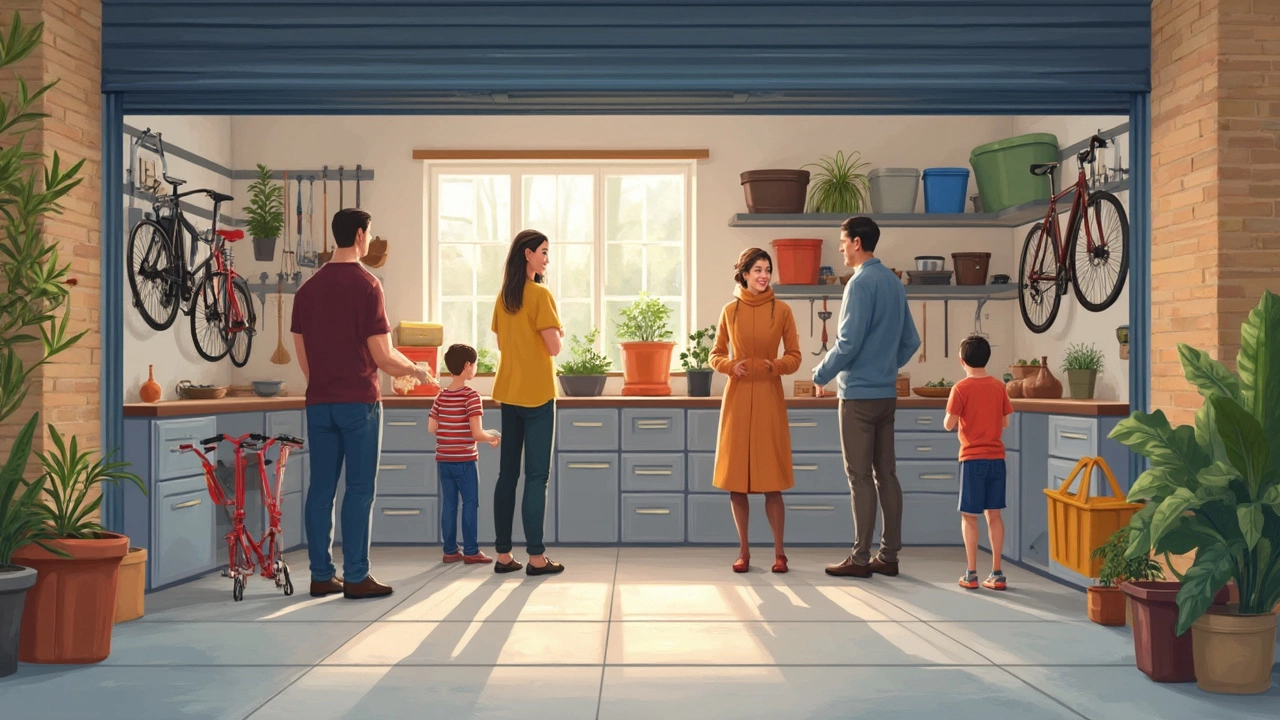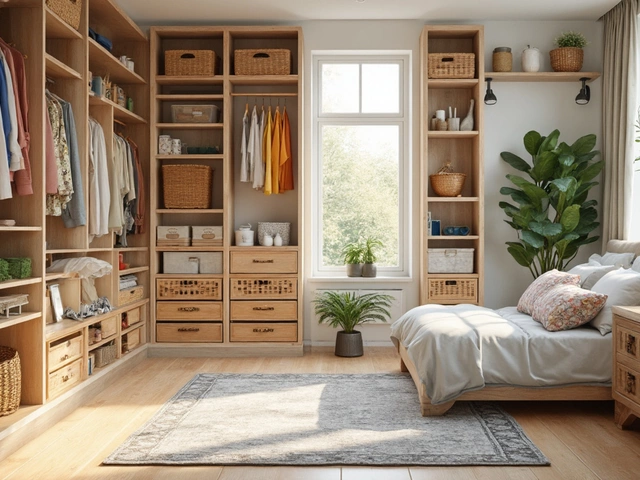You’d think a 5 bedroom house means endless space, right? But somehow, most people are still running out of room. There’s kid stuff, kitchen stuff, seasonal gear, and let’s not even talk about all the random things you swear you’ll use again someday. So, how much storage do you actually need?
The short answer: a lot depends on your lifestyle and just how much you own. If you’re moving in or trying to finally get organized, it helps to get honest about your “stuff situation.” Are your closets bursting at the seams? Do you have boxes you haven’t opened in years? Start by listing out what you have, and flag anything you haven’t used in ages. Most big families find that once they go through everything, about a third of their stuff can actually be donated or tossed—free storage win right there.
- Sizing Up Space: How Much Stuff Do You Really Have?
- Room-by-Room Storage Musts
- Hidden Storage Spots and Smart Hacks
- Planning for Growth (and Avoiding Clutter Overload)
Sizing Up Space: How Much Stuff Do You Really Have?
You can’t plan storage for a 5 bedroom house if you’re just guessing what you own. The fastest way to get real answers is to actually walk through your house and take stock. Most people seriously underestimate how much space they’ll need for clothes, kitchen gear, holiday decorations, and the weird little things that pile up over time.
Here’s a quick look at what you might typically find in a house this size:
| Area | Average # of Items | Typical Storage Needed |
|---|---|---|
| Master Bedroom | 250+ (clothes, shoes, accessories) | 10-14 linear feet of closet |
| Each Extra Bedroom | 150+ (toys, bedding, clothes) | 6-10 linear feet per room |
| Kitchen | 400+ (utensils, pans, pantry) | 18-25 cabinets plus pantry |
| Garage/Basement | 100+ (tools, sports, storage bins) | 6-10 shelves plus open floor |
| General Storage | Varies (books, seasonal, keepsakes) | 5-10 bins per person |
Surprised? Most new homeowners are. This isn’t even counting the attic or the ‘junk drawer’ we all pretend isn’t overflowing.
If you want a quick, non-overwhelming system, try this:
- Grab a notepad (or your phone) and go room by room.
- Jot down what’s in each closet, cabinet, or drawer. You don’t need exact counts—rough categories work.
- Flag anything you haven’t used in a year. This is your fast track to freeing up space without any drama.
Pro tip: The average US household owns about 300,000 items, big and small. Even in a spacious home, stuff creeps up fast. The goal isn’t to become a minimalist, but to give everything a spot so your storage needs don’t explode.
Room-by-Room Storage Musts
Every five-bedroom house packs its own storage challenges. Each room needs a slightly different game plan to keep things under control. So, let’s get specific and zoom in on what actually works for each area.
Storage needs in bedrooms usually get maxed out fast, especially for families. Each bedroom should have at least one spacious closet (about 5-8 linear feet wide). For kids, double rails in closets and under-bed bins will save your sanity, since toys and seasonal clothes multiply out of nowhere. In the primary bedroom, people often regret not having enough shoe racks or drawer dividers. If you’re dealing with smaller closets, wall hooks and stacked boxes help squeeze out extra space.
The kitchen is the battle zone for clutter. According to the National Kitchen and Bath Association, the average kitchen needs about 25 linear feet of cabinets and 6-8 feet of pantry shelving in homes this size. Pull-out shelves, deep drawers, and lazy Susans help store bulky appliances and all those random gadgets. Don’t forget to stash bulky stockpots and pancake griddles down low.
Check out this quick comparison of storage by room, based on what professional organizers recommend for a five-bedroom house:
| Room | Recommended Storage | Tips |
|---|---|---|
| Bedroom | 1 large closet per room (5-8 ft), under-bed drawers, dressers | Double closet rails for kids, shoe racks for adults |
| Kitchen | 25 linear feet cabinet, 6-8 ft pantry shelves | Pull-out shelves & deep drawers for pots, upright dividers for pans |
| Living Room | TV stand storage, bookshelves, hidden ottomans | Purge dusty media, use baskets for remotes and cords |
| Bathroom | 2-3 shelves or cabinets, drawer organizers | Use baskets under sinks, vertical shelves above toilet |
| Entryway | Closet (min 4 ft), shoe racks, wall hooks | Bench with shoe storage saves morning chaos |
Don’t forget basements, attics, or garages. Sturdy shelves or metal racks are key out there, especially if you’re storing holiday decor, sports gear, or tools. Just make sure you keep everything off the floor when possible—nobody enjoys cleaning out a musty, cluttered corner after a leak.
Simple rule: if you haven't used something in a year (besides keepsakes), it’s taking up space you probably need. Organize each room in short bursts—no one needs to lose a weekend to decluttering madness.

Hidden Storage Spots and Smart Hacks
If you think you’ve run out of room, look again—most 5 bedroom homes have sneaky places to stash things if you know where to look. Start with under the beds: huge storage bins can slide right under there, perfect for off-season clothes, shoes, or even toys kids forget about. A queen-size bed frame fits at least four shallow plastic containers—no tools needed, just a tape measure first.
Next up: the garage and attic. Folks usually treat these as dumping grounds, but you can turn them into organized zones with big clear tubs, shelves, and even ceiling-mounted racks. There’s legit data showing well-planned vertical storage in the garage or attic can clear up to 25% more floor space. Just be careful with temperature-sensitive stuff—don’t store family photos or electronics up there.
Don’t forget backs of doors. Hanging organizers—think shoe racks or pocket fabric holders—turn wasted space into bonus storage for cleaning supplies, scarves, or pet things. Deep kitchen drawers? Use stackable bins or drawer dividers to double what you can put in there. Even awkward corners in laundry rooms or mudrooms become useful when you stick shelves or wall hooks there.
If you need to hide clutter quick or just crave a tidy look, try these smart hacks:
- Buy ottomans, benches, or coffee tables with hidden compartments for extra blankets, board games, or even remotes you never find.
- Use labeled bins or baskets inside closets, so everything has a home and you don’t waste time hunting.
- Upgrade your storage needs with closet systems (the adjustable kind from big-box stores work just fine) to squeeze in more shoes, bags, or kids’ stuff.
- Pick beds with built-in drawers for bedrooms without roomy closets.
The best part? You don’t need a big renovation budget or fancy tools to pull this off—just a good label maker, some storage bins, and a weekend.
Planning for Growth (and Avoiding Clutter Overload)
When you live in a five bedroom house, "stuff creep" is real. You start with plenty of empty shelves, only to find every closet and cabinet full a year later. The best way to handle this is to plan for what your storage needs will look like down the road, not just right now.
First, consider the major life changes that can increase your storage needs. Expecting a baby? Growing kids? Taking care of aging parents or working from home? These all come with extra gear, clothes, or furniture. According to a 2023 survey by The Home Edit, families with two or more kids reported a 35% increase in storage needs in just three years.
If you want to keep your home usable and avoid a giant mess, set some clear storage needs limits for each space. One easy rule is the "one in, one out" trick. Every time you buy something new—say, a kitchen gadget or a pair of shoes—something old has to go. It sounds simple, but it seriously cuts down on clutter.
Another tip: leave at least 15% of each storage area (closet, cabinet, or shelf) empty. That gives you room for future purchases, gifts, or changes in lifestyle. Here's a quick look at how fast stuff tends to pile up by household size:
| Household Size | Average Yearly Storage Increase (% of current storage filled) |
|---|---|
| Single Adult | 5% |
| Couple (no kids) | 8% |
| Family of 4 | 12% |
| 5+ People | 15% |
Finally, set reminders (once or twice a year) to review your storage spaces. Schedule a short "purge" session in spring or fall—donate what you don't use, toss broken stuff, and make sure the storage systems you set up still match your actual needs. Trust me, future-you will thank you.


